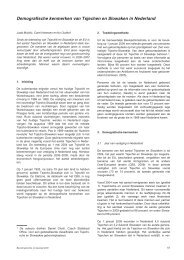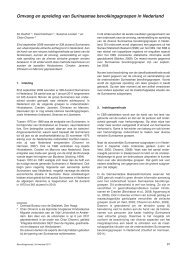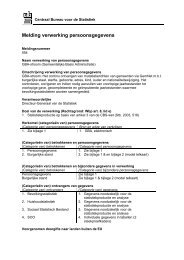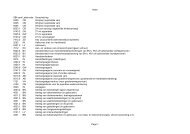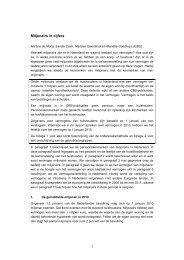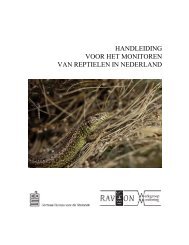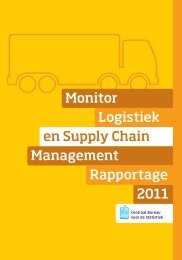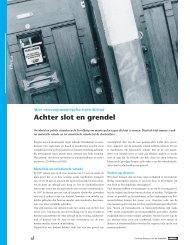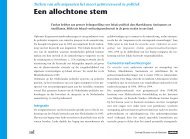Methoden voor de berekening van de emissies door mobiele ... - CBS
Methoden voor de berekening van de emissies door mobiele ... - CBS
Methoden voor de berekening van de emissies door mobiele ... - CBS
Create successful ePaper yourself
Turn your PDF publications into a flip-book with our unique Google optimized e-Paper software.
1.3 Description of the process<br />
With the exception of a relatively small number of electric vehicles, road vehicles are equipped with a<br />
combustion engine for propulsion. In such engines, the chemical energy of fuels such as petrol, diesel<br />
and LPG is converted into mechanical energy. During this conversion process, various substances are<br />
emitted via the exhaust. In addition, emissions are created by the evaporation of motor fuels and<br />
coolants, the wear of brakes, tyres and the road surface, and the leakage and consumption of motor<br />
oil. Depending on the emission component, a specific calculation method has been chosen for the<br />
emission-causing processes:<br />
Combustion emissions (via the exhaust)<br />
Carbon monoxi<strong>de</strong> (CO), volatile organic compounds (VOC) 3 , nitrogen oxi<strong>de</strong>s (NOx), nitrous oxi<strong>de</strong><br />
(N20), ammonia (NH3) and particulate matter (PM10). These emissions <strong>de</strong>pend primarily on the<br />
type of fuel, the engine technology and exhaust gas aftertreatment technology as well as driving<br />
behaviour. These emissions are calculated by multiplying vehicle performance figures (vehicle<br />
kilometres) and emission factors (in grams per vehicle kilometre). Since 2006 the emission factors<br />
are calculated with the empirical emissions mo<strong>de</strong>l VERSIT+.<br />
Sulphur dioxi<strong>de</strong>, carbon dioxi<strong>de</strong> and heavy metals (including lead). These emissions <strong>de</strong>pend on<br />
fuel consumption and the type of fuel. The emission calculation takes place by multiplying the fuel<br />
consumption with emission factors in grams per litre of fuel consumed (based on the content of<br />
sulphur, carbon and heavy metals in the fuel).<br />
VOC components. These components comprise a large group of divergent substances. VOC in<br />
exhaust gas can be subdivi<strong>de</strong>d into alkanes, alkenes, aromatics (including benzene), polycyclic<br />
aromatic hydrocarbons (PAHs) and chlorinated hydrocarbons. Calculation of the various VOC<br />
components takes place by multiplying the total VOC emission with the VOC profile, to obtain the<br />
composition of the VOC according to substance groups (e.g. aromatics, alkanes) and individual<br />
chemical substances (e.g. benzene, formal<strong>de</strong>hy<strong>de</strong>).<br />
Evaporative emissions (from the fuel system of petrol vehicles)<br />
VOC total and VOC components. VOC emissions caused by evaporation are calculated<br />
by multiplying the number of vehicles with emission factors expressed in grams per<br />
vehicle per day. The emission factor <strong>de</strong>pends on the year of manufacturing of the vehicle<br />
because the <strong>de</strong>mands regarding the maximum quantity of evaporation from a vehicle have<br />
become increasingly strict over the years.<br />
Emissions caused by wear processes<br />
PM10 emission caused by the wear of tyres, brakes and the road surface. Calculation<br />
takes place by multiplying the total particle matter emission per tyre per vehicle kilometre<br />
with a factor for the share of PM10 in the total emission; then this emission factor is<br />
multiplied by the number of tyres per vehicle and by the number of vehicle kilometres per<br />
vehicle category;<br />
Heavy metals and PAHs caused by the wear of tyres, brakes and the road surface. In<br />
many cases, particulate matter emission originating from the wear of tyres, brakes and the<br />
road surface contain heavy metals and PAHs. Calculation takes place by means of<br />
profiles that <strong>de</strong>scribe the content of heavy metals and PAHs in the total particulate matter<br />
emission.<br />
Other emissions<br />
Heavy metals and PAHs from the leakage of engine oil. Calculation takes place by<br />
combining data about total engine oil leakage (based on the amount of gaskets) per<br />
vehicle per year and the content of heavy metals and PAHs in lubricants;<br />
Heavy metals due to the consumption (combustion) of engine oil. Calculation takes place<br />
by combining data about the total consumption of engine oil (leakage via the piston rings<br />
into the combustion chambers) per vehicle per year and the content of heavy metals and<br />
PAHs in lubricants.<br />
3<br />
VOC are also called hydrocarbons (HC or CH).<br />
15





